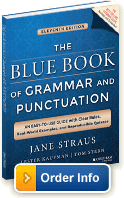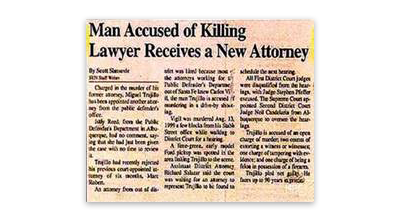|
Welcome to your GrammarBook.com e-newsletter.
|
“I appreciate having The Blue Book of Grammar and Punctuation readily available for quick reference.”
—Charlie S.
“I have been exploring GrammarBook.com and would like to say how much I like the wonderful content and the clean, uncluttered look.”
—Suzy H.
“Your wonderful way of explaining grammar concepts has taught me how to teach my students.”
—Amy A.
|
|
|
Rules, Policies, and Judgment Calls
Readers seemed to enjoy “Are Two r’s One Too Many?” our column about the pronunciation of February. But we also
received a few emails like this one: “Why on earth is there an apostrophe in the title??”
We understand the reader’s concern. Starting in grade school, English teachers rail against sentences like “Banana’s make good
snack’s.” Students learn early on that only careless or clueless writers use apostrophes to pluralize nouns.
However, there are certain exceptions. When a rule leads to perplexity rather than clarity, writers and editors will make adjustments. For instance, the
use of apostrophes strikes us as the simplest and most practical way to pluralize is and was in a sentence like Jones uses too many is’s and was’s. You may feel you have a better solution, but the is’s and was’s solution is
not wrong. It is endorsed by many reputable language authorities.
These days, initialisms like TV or RSVP are made plural simply by adding a lowercase s without an apostrophe: TVs, RSVPs. But to pluralize abbreviations that end in S, we advise using an apostrophe: They sent out two SOS’s.
Imagine the confusion if you wrote My a’s look like u’s without apostrophes. Readers would see as and us, and feel
lost.
This brings us back to our title and the phrase “two r’s.” The Chicago Manual of Style (CMOS) endorses “Mind your p’s and q’s.” The Practical English Handbook by Floyd C. Watkins, William B. Dillingham, et
al., sanctions “four c’s,” but the book also accepts “four cs,” presumably because the difference between c in italics and s in roman typeface is sufficient for attentive readers.
There is no definitive rule for using apostrophes (or not) to form plurals in special cases like these. For many decades The New York Times wrote the 1920’s. Then the paper changed its policy in late 2012, and now writes the 1920s like most of the rest of us. And though CMOS recommends “p’s and q’s,” it prefers yeses and nos to yes’s and no’s. One
wonders if CMOS would prefer ises and wases to is’s and was’s—because to us, ises and wases is too
obscure to be a practical solution.
So to avoid similar confusion, we went with “Two r’s” and not “Two rs” in our title. We didn’t feel
comfortable signing off on something that looked like a typo.
Because of the e-newsletter’s large readership, please submit your English usage questions through GrammarBook.com’s “Grammar Blog.” |
|
Free BONUS Quiz for You!
[[firstname]], because you are a subscriber to the newsletter, you get access to one of the Subscription Members-Only Quizzes. Click here to take an Apostrophes Quiz and get your scores and explanations instantly!
More Good News for Quiz Subscribers
We are pleased to announce that we have added even more quizzes to help you challenge yourself, your students, and your staff. We added quizzes to existing categories and created some new categories such as “Confusing Verbs,” “Subjunctive Mood,” “Comprise,” and “Sit vs. Set vs. Sat.”
We reviewed and strengthened every quiz on our website to ensure consistency with our rules and guidelines contained in the eleventh edition of The Blue Book of Grammar and Punctuation.
If you think you have found an error in a quiz, please email us at help@grammarbook.com.

“So convenient … hundreds of quizzes in one click.”
[[firstname]], Subscribe to receive hundreds of English usage quizzes not found anywhere else!
- Take the quizzes online or download and copy them.
- Get scored instantly.
- Find explanations for every quiz answer.
- Reproduce the quizzes to your heart’s content.
- EASY to use.
- No software to download.
- No setup time.
- A real person to help you if you have any questions!
Instructors and Employers: we make your life easier!
- Assign quizzes to your students or employees.
- Students log in from anywhere.
- Scores are tallied and compiled for you.
- You decide whether to let students see their own scores and quiz explanations.
- Let GrammarBook.com take the hassle out of teaching English!
“Fun to test my skills!”
“The explanations really help … thanks!”
Your choice: Subscribe at the $29.95 or $99.95 level ($30 off - previously $129.95).
“I download the quizzes for my students who don’t have computer access.”
Subscribe today to receive hundreds of English usage quizzes not found anywhere else!
“Makes learning English FUN!”
 |
Don’t need all the quizzes at once?
You can now purchase the same quizzes individually for ONLY 99¢ each. Purchase yours here. |

Get Yours Today!
Get Amazon’s No. 1 Best-seller in Four Categories!
No. 1 in Grammar
No. 1 in Reading
No. 1 in Lesson Planning
No. 1 in Vocabulary |
The Blue Book of Grammar
and Punctuation
by Jane Straus, Lester Kaufman, and Tom Stern
The Authority on English Grammar!
Eleventh Edition Now Available
Have You Ordered Your Copy Yet?
An indispensable tool for busy professionals, teachers, students, homeschool families, editors, writers, and proofreaders.
Available in print AND as an e-Book! Over 2,000 copies are purchased every month!
Order Your Copy Today!
- Hundreds of Grammar, Punctuation, Capitalization, and Usage Rules
- Real-World Examples
- Spelling / Vocabulary / Confusing Words
- Quizzes with Answers
The publisher is extending its pre-publication discount offer until April 30, 2015! If you live in the United States or Canada, order the new edition of The Blue Book
through Wiley.com and get 30 percent off and FREE shipping. Simply go to bit.ly/1996hkA and use discount code E9X4AYY.
For those of you who live outside the U.S. and Canada, although the publisher is not able to offer free shipping, you will get 35 percent off to help offset your shipping costs. Simply go to bit.ly/1996hkA and use discount code E9X4A. |
Wordplay
If these newspaper headlines found circulating the Internet are authentic, they surely demonstrate an absence of thoughtful editing.


Learn all about who and whom, affect and effect, subjects and verbs, adjectives and adverbs, commas, semicolons, quotation marks, and much more by just sitting back and enjoying these easy-to-follow lessons. Tell your colleagues (and boss), children, teachers, and friends. Click here to watch. |







